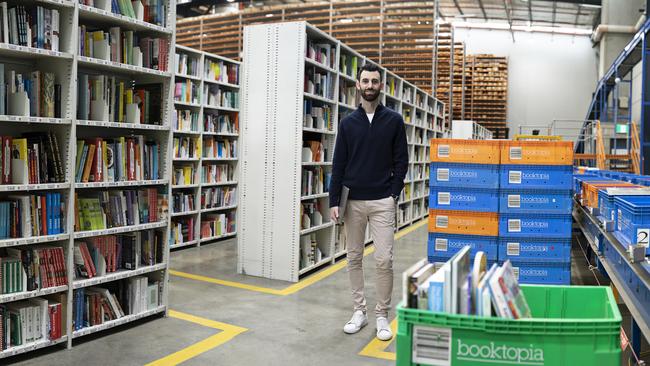Australian insolvency rates passes Global Financial Crisis highs as economic woes bite
Australia has had its worst year for insolvencies, passing highs set during the GFC, with experts predicting more large companies will follow Bonza and Booktopia into strife this year.

Business
Don't miss out on the headlines from Business. Followed categories will be added to My News.
Business failures surged to a record high in the past financial year as deteriorating economic conditions combined with rising operating expenses forced many companies to close for good amid the threat of a rate hike when the Reserve Bank meets next month.
And insolvency experts warn that the number of company failures won’t slow for some time, with more medium and larger corporations tipped to fall over in the coming year.
Figures from the Australian Securities & Investments Commission show there were 11,049 insolvency appointments in the 2024 financial year, a 39.1 per cent increase on the 7942 appointments a year prior, and 124 per cent more than 2022.
The past financial year had the highest rate of external administration and controller appointments since ASIC records began in the late 1990s, surpassing the previous high of 2012 when 10,757 businesses went under amid the fallout of the Global Financial Crisis.
Gayle Dickerson, KPMG’s national leader, turnaround and restructuring, said the record year suggested there were risks ahead for the broader economy, and that impacts will spread more to medium and large businesses as options that they previously had access to were exhausted.
“While we have more businesses than in the GFC, this result is very significant and it just increases the risk across the economy for all businesses in terms of who they’re dealing with, but it’s certainly been a busy time in the turnaround sector,” she said.
“We’re seeing more in that liquidity solvency crisis area from businesses now than 12 months ago, with more issues around the profitability aspects.”
There were 3.38 million businesses registered in Australia in June compared to 1.13 million in 1999 and 1.88m in 2012, according to ASIC.
Ms Dickerson, who also sits on the Turnaround Management Association board, told The Australian that there would be a lag effect in insolvencies as seen during the GFC, when the number did not peak until more than two years after the collapse of Lehman Brothers.
“We’re seeing something similar to the Lehman Brothers in that after it crashed it took a few years later before we saw peak. Likewise right now the event of Covid and the flow-on effect still has some time to play out before it gets better for businesses,” she said.
“We’re not at the peak yet. The consensus and my view is we’ve probably got another 12 months really kind of still ramping up before we hit the peak.”
The number of insolvencies dipped to as low as 4235 during the height of Covid-19 in 2020-21, when temporary measures were put in place by the Morrison government to protect vulnerable businesses from the economic shock of the pandemic.
However, with the safety net removed and the economy slowing in the face of rampant inflation and rapid fire interest hikes by the Reserve Bank, businesses in industries ranging from construction to hospitality and retail have battled for survival.
The construction sector had the highest number of insolvencies in the 12 months to June 30 of 2975 — 34.4 per more than its previous record of 2213 set in the 2023 fiscal year. Apartment developer Crown Group was among the biggest casualties after the liquidators were appointed to the apartment behemoth and 40 of its entities.

Accommodation and food services insolvency appointments continued to grow at a faster rate of 50 per cent to 1667, and retail trade appointments surged 42.2 per cent over the year to 768.
A deterioration in economic conditions coupled with poor consumer sentiment claimed several high profile victims including online bookseller Booktopia, which entered into voluntary administration at the end of June, owing more than $60m.
Godfreys Group, the iconic retailer of vacuums that has been selling cleaners for almost 100 years, collapsed in January and closed for good in May, while Chinese variety retailer Miniso placed 21 stores into administration.
Failed budget airline Bonza ceased to exist after it entered into voluntary administration in April as its fleet of Boeing 737 Max 8s were repossessed by AIP Capital.
It was found to owe in excess of $110m to about 60,000 creditors including customers, employees, airports, traders and 777 Partners, the airline’s US owners.

Interest rate hikes and cost-of-living pressures crushed consumption and forced many business to close, with the gross domestic product up 1.4 per cent in the year to March – the weakest growth in two decades, outside the Covid pandemic.
Macquarie Group chairman and former Reserve Bank governor Glenn Stevens said ahead of next month’s lineball rate decision that central banks globally face a delicate situation.
“Inflation has come down, is it fast enough, is it low enough? That’s the judgment they have to make. Economies have been resilient and probably a bit more resilient, actually than most would have expected thus far,” he said.
Australian Restructuring Insolvency and Turnaround Association chief executive John Winter said the Australian Taxation Office had launched an overdue cleanout of failed businesses that should have gone during the pandemic as it resumed cracking down on unpaid debt.
“What’s being shut down now as a direct result of the ATO being properly back in the market, are businesses that were largely abandoned or should have been abandoned, or weren’t far off,” he said.
“The ATO is doing exactly what it should be doing. You can’t allow businesses to rack up tax debt, which is not proper debt and they need to be held to account.
“When the ATO takes action it is being enforced on you as an individual, not against the company, and that actually drives people to make the decision to actually put their own business into an insolvency process.”

Many of the businesses targeted by the ATO have included small construction, retail and hospitality firms that have racked up tax debt during the pandemic.
CreditorWatch chief executive Patrick Coghlan said smaller businesses were feeling the brunt of economic pressures more acutely and were much less confident about their financial health than larger firms.
“Businesses are really hurting. They are experiencing a combination of rapid price increases, a series of interest rate hikes, and rising wage costs. On top of that, cost-of-living pressures mean that consumer demand has fallen away,” he said.
“Smaller businesses, operating on tighter margins and with depleted cash reserves, are struggling the most.”
NSW had a record year for insolvencies with 4634 instances, while Victoria had 2862 and Queensland recorded 2036 appointments.
More Coverage
Originally published as Australian insolvency rates passes Global Financial Crisis highs as economic woes bite





